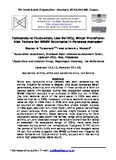Temperature fluctuation, low salinity, water microflora: Risk factors for WSSV outbreaks in Penaeus monodon.
Share
Abstract
White spot syndrome virus (WSSV) has been devastating the shrimp industry for almost a decade. This study compares water parameters, alkalinity, and microflora in three ponds on a farm on Negros Island (Philippines) during two production cycles where WSSV infection resulted in an outbreak in 2006 but not in 2005. The total bacterial count of the pond water in 2005 was about twice as high as in 2006. However, luminous bacterial counts were twice as high in 2006 than in 2005 and total presumptive Vibrio, as counted on Vibrio selective thiosulfate citrate bilesalt sucrose (TCBS) agar, was over ten times higher, with a greater percentage of green colonies. More green colonies might indicate a higher concentration of harmful Vibrio bacteria. Total alkalinity for both production cycles was within the normal range while temperature, salinity, pH, and dissolved oxygen varied and sometimes fell below or exceeded the acceptable range. In 2006, there were more instances during which the temperature fluctuated 3-4°C within the period of 07:00-17:00, and salinity more often dropped below 15 ppt. Our survey suggests that WSSV outbreak are triggered by water temperature fluctuations of 3-4°C, coupled with low salinity and a high presumptive Vibrio count
Suggested Citation
Tendencia, E., & Verreth, J. A. (2011). Temperature fluctuation, low salinity, water microflora: Risk factors for WSSV outbreaks in Penaeus monodon. The Israeli Journal of Aquaculture-Bamidgeh , 63, 548. http://hdl.handle.net/10862/1618
Collections
- AQD Journal Articles [1248]

